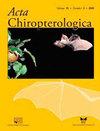蝙蝠脱发:以墨西哥四种蝙蝠为例
IF 0.7
4区 生物学
Q4 ZOOLOGY
引用次数: 0
摘要
秃发或秃发综合症是指动物身体部分或全部失去毛发。继之前关于秃顶蝙蝠的报道之后,本研究补充了截至2023年文献中已有的秃顶蝙蝠物种列表,增加了phyllostomids (Artibeus planirostris, Carollia perspicillata)、ballonurids (Peropteryx pallidoptera)、Molossus rufus、Nyctinomops macrotis)和vespertilionids (Corynorhinus rafinesquii、Eptesicus fuscus、Nycticeius humeralis、Myotis austroriparius、M. grisescens、M. velifer)。我们还在2020年11月至2022年1月记录的墨西哥东南部瓦哈卡州10只雌性中美洲翼龙的首次记录中探索了可能解释脱发的因素。在这些人中,背部和头部出现脱发;其中6只正在哺乳,4只没有显示出生殖活动的迹象。此外,我们还记录了3个物种的4个个体的胸部脱发:Artibeus lituratus(1名怀孕的雌性和1名有阴囊睾丸的雄性),Pteronotus fulvus(1名怀孕的雌性)和Artibeus toltecus(1名怀孕的雌性)。秃蝠表现为轻度脱发(发病面积为1 ~ 5 cm2),雌蝠仅有1只表现为中度脱发(8.1 cm2)。中美洲猿人、黄斑猿人、toltecus猿人和lituratus猿人的脱发可能是由于与生殖有关的激素或营养失衡。此外,在城市地区觅食时,也可能是环境压力的结果。蝙蝠脱发的致病因子尚不完全清楚,它可能是一个多因素现象。秃发症,也就是síndrome秃发症是一种特殊的疾病,特别是在动物身上。2009年1月1日,在文献资料中,我们发现了斑秃的murciciosis,并发现了斑秃的murciciosis,并发现了斑秃的murciciosis。我们发现了filostómidos (planirostris, carcarlia perspicillata), embalonúrido (peroptertera), molósidos (Molossus rufus, Nyctinomops macrotis)和vespertiliónidos (Corynorhinus rafinesquii, Eptesicus fuscus, Nycticeius humeralis, Myotis austroriparius, M. grisescens, M. velifer)。加入exploramos危险因素是乙醇explicar拉脱发在洛杉矶首先registros esta身体en diez de hembras de Pteronotus mesoamericanus德瓦哈卡州,墨西哥sureste registradas desde noviembre 2020直到enero区2022。所有个人都看到observó passrdida de pelo En el dorso y la cabeza;这两种动物都有繁殖能力,但没有证据表明它们有繁殖能力。Además, documentamos alopecia en el tórax en cuatro individuos de res species: Artibeus lituratus (una hembra gestante) y un macho con testículos escrotados), fulonotus (una hembra gestante) y Artibeus toltecus (una hembra gestante)。murciciacos和alopacacos表现为脱发级别(el área afectada osciló中心1-5 cm2),而solo una hembra presentó中度脱发(8.1 cm2)。黄斑病、黄斑病、黄斑病、黄斑病、黄斑病、黄斑病、黄斑病、黄斑病、黄斑病、黄斑病、黄斑病、黄斑病、黄斑病等。Además, za . lituratus tamamicans和tamamicans的环境关系与tamamicans的环境关系与tamamicans的环境关系与tamamicans的环境关系área urbana。造成斑秃的主要原因aún与完全性差无关,但可能是多因素的fenómeno。本文章由计算机程序翻译,如有差异,请以英文原文为准。
Alopecia in Bats: A Case Study of Four Species from Mexico
Alopecia, or alopecia syndrome is the partial or complete loss of hair from an animal's body. Following a previous report on bats with alopecia, in this work we complemented the list of bat species with alopecia available in the literature through 2023, adding phyllostomids (Artibeus planirostris, Carollia perspicillata), an emballonurid (Peropteryx pallidoptera), molossids (Molossus rufus, Nyctinomops macrotis), and vespertilionids (Corynorhinus rafinesquii, Eptesicus fuscus, Nycticeius humeralis, Myotis austroriparius, M. grisescens, M. velifer). We also explored factors that may explain alopecia in the first records of this condition in ten Pteronotus mesoamericanus females from Oaxaca, southeastern Mexico, recorded from November 2020 to January 2022. In those individuals, hair loss was observed on the back and head; six of them were lactating and four showed no evidence of reproductive activity. In addition, we documented alopecia on the thorax in four individuals of three species: Artibeus lituratus (one pregnant female and one male with scrotal testes), Pteronotus fulvus (one pregnant female), and Artibeus toltecus (one pregnant female). The alopecic bats presented mild alopecia (the affected area ranged from 1–5 cm2), and only one female showed moderate alopecia (8.1 cm2). Alopecia in P. mesoamericanus, P. fulvus, A. toltecus, and A. lituratus may be due to hormonal or nutritional imbalances associated with reproduction. In addition, in A. lituratus it may also be the result of environmental stress when foraging in an urban area. The causal agents of alopecia in bats are still not fully known, and it is probably a multifactorial phenomenon. La alopecia, o síndrome de alopecia es la pérdida parcial o total del pelo del cuerpo de un animal. Siguiendo un informe previo sobre murciélagos con alopecia, en este trabajo complementamos la lista de especies de murciélagos con alopecia disponibles en la literatura hasta 2023, agregando filostómidos (Artibeus planirostris, Carollia perspicillata), un embalonúrido (Peropteryx pallidoptera), molósidos (Molossus rufus, Nyctinomops macrotis) y vespertiliónidos (Corynorhinus rafinesquii, Eptesicus fuscus, Nycticeius humeralis, Myotis austroriparius, M. grisescens, M. velifer). También exploramos los factores que pueden explicar la alopecia en los primeros registros de esta condición en diez hembras de Pteronotus mesoamericanus de Oaxaca, sureste de México, registradas desde noviembre de 2020 hasta enero de 2022. En esos individuos se observó pérdida de pelo en el dorso y la cabeza; seis de ellos estaban lactando y cuatro no mostraron evidencia de actividad reproductiva. Además, documentamos alopecia en el tórax en cuatro individuos de tres especies: Artibeus lituratus (una hembra gestante y un macho con testículos escrotados), Pteronotus fulvus (una hembra gestante) y Artibeus toltecus (una hembra gestante). Los murciélagos alopécicos presentaron alopecia leve (el área afectada osciló entre 1–5 cm2), y solo una hembra presentó alopecia moderada (8.1 cm2). La alopecia en P. mesoamericanus, P. fulvus, A. toltecus y A. lituratus puede deberse a desequilibrios hormonales o nutricionales asociados con la reproducción. Además, en A. lituratus también puede ser el resultado del estrés ambiental cuando se alimenta en un área urbana. Los agentes causales de la alopecia en murciélagos aún no se conocen por completo, y probablemente se trate de un fenómeno multifactorial.
求助全文
通过发布文献求助,成功后即可免费获取论文全文。
去求助
来源期刊

Acta Chiropterologica
生物-动物学
CiteScore
2.50
自引率
20.00%
发文量
42
审稿时长
>12 weeks
期刊介绍:
Acta Chiropterologica, published by the Museum and Institute of Zoology at the Polish Academy of Sciences, is devoted solely to the study and discussion of bats.
 求助内容:
求助内容: 应助结果提醒方式:
应助结果提醒方式:


